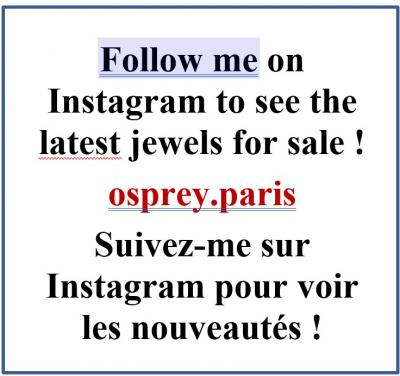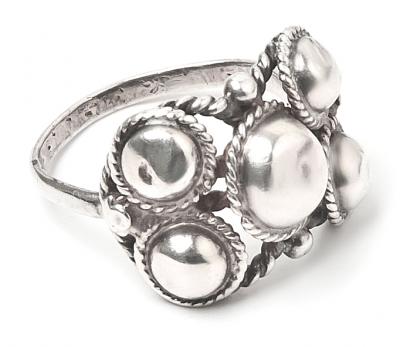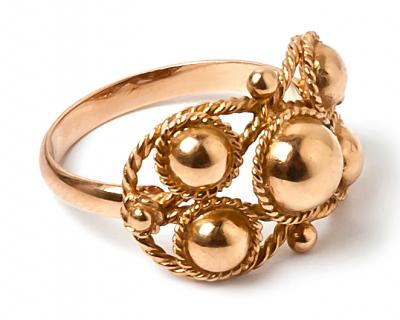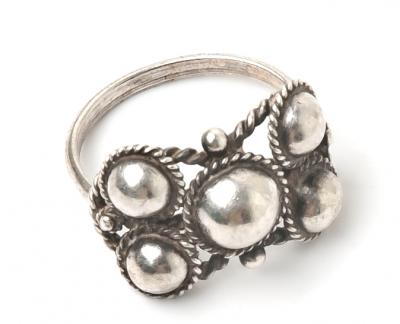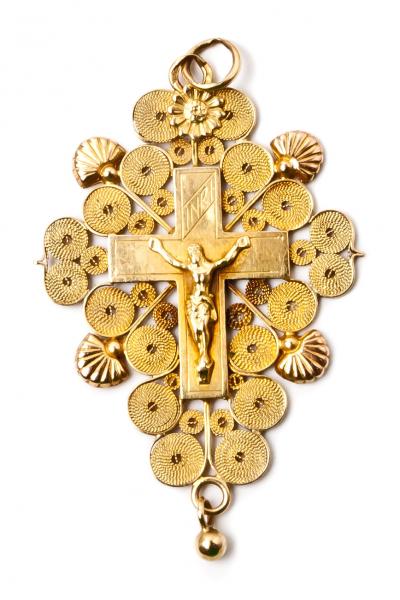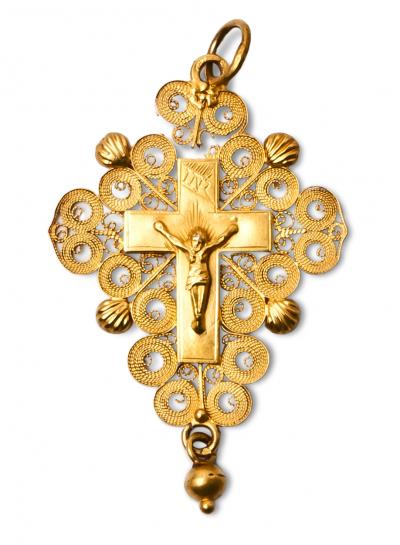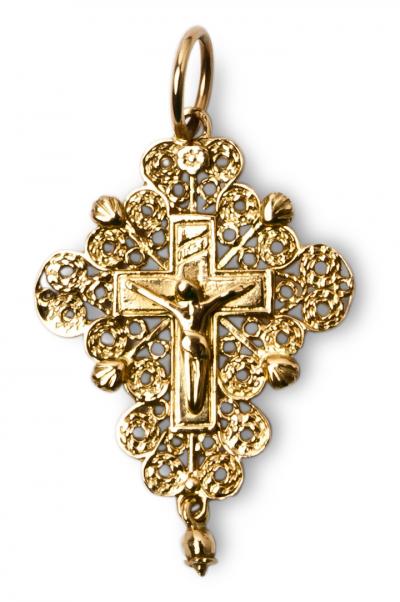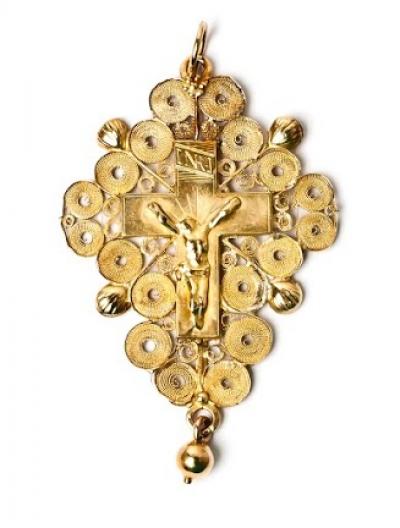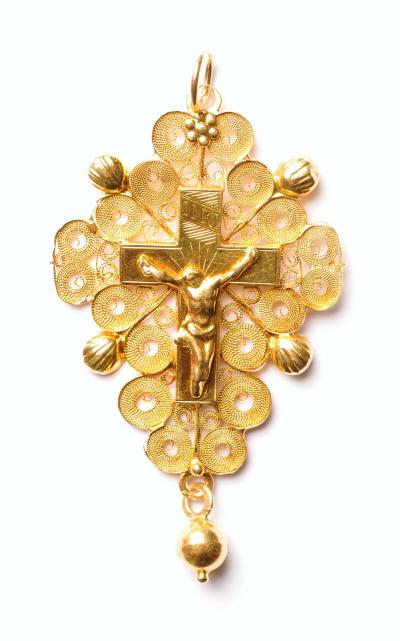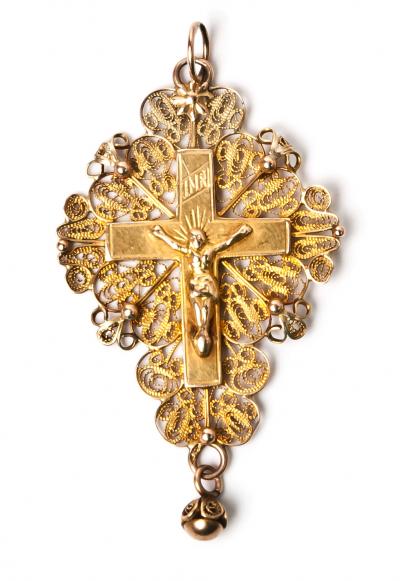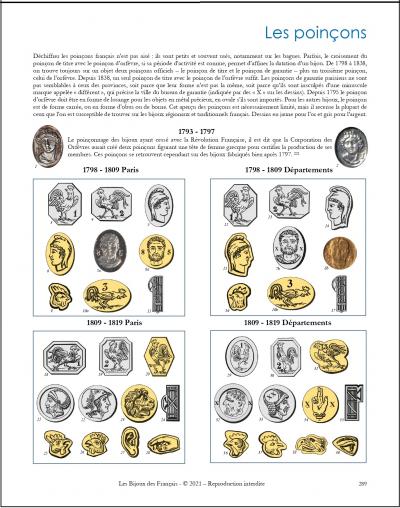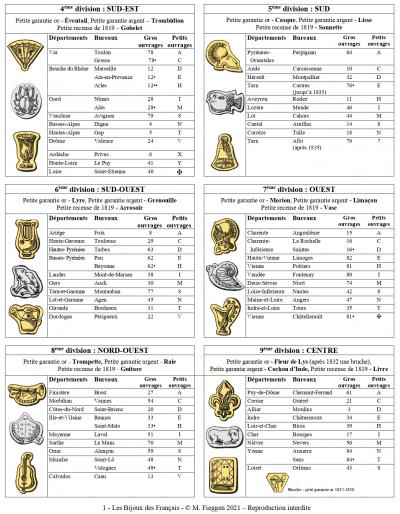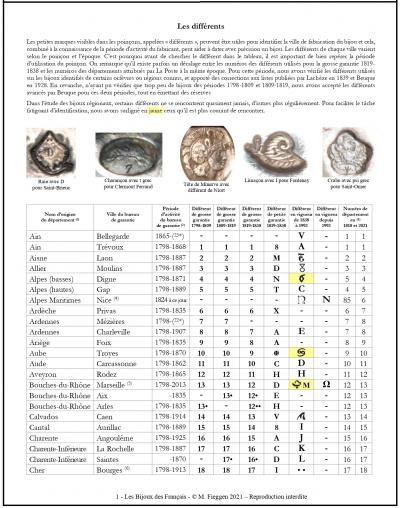North / Pas-de-Calais

North - Artois - Flanders region
BIJOUX REGIONAUX ANCIENS - BIJOU REGIONAL
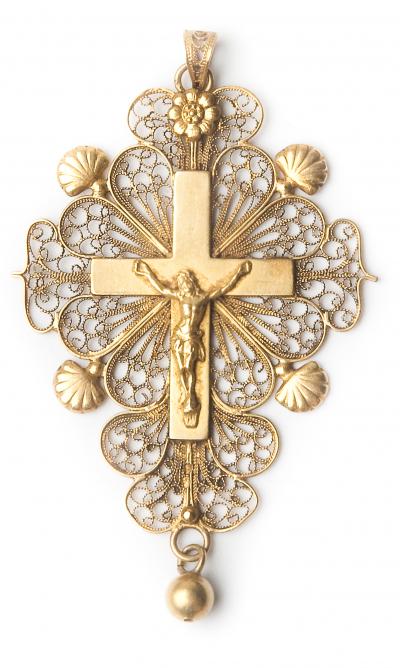
finely worked Boulogne cross, gold and filigree work
Earrings - ear-pendants
|
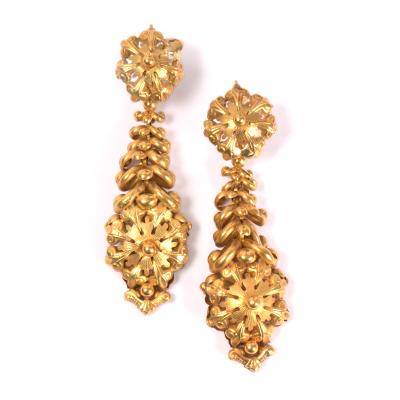
Milanos ear pendants, gold, northern coastal region
|
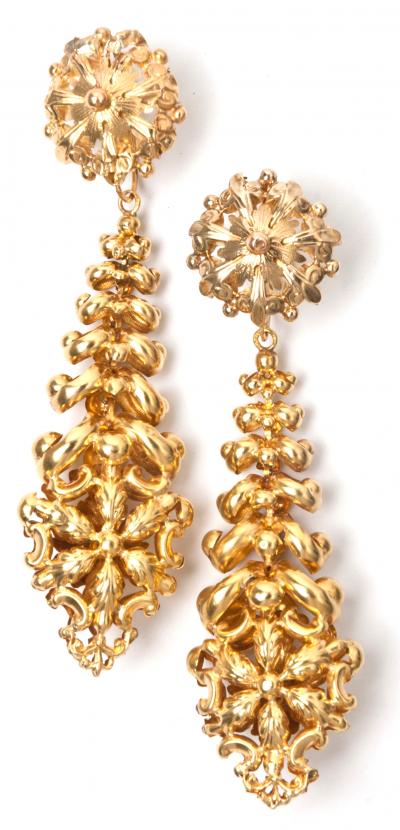
Milanos ear pendants, gold
|
|
The region between Boulogne sur Mer and Calais is very rich in regional jewellery. The fishermen had an extrememly dangerous job, compensated for by incomes a good deal higher than most other trades and they liked to show off their success and their membership of a rather closed community. The traditional ensemble of a fisherman's wife consisted of a pair of long ear pendants called Milanos, a pardon cross in gold filigree, a love knot or a Lisbonne ring and a long neck chain called sorcière with a large catch in the shape of a barrel.
The Milanos ear pendants take their name from the idea that they are made of a thousand rings, mille anneaux even though they have less than a dozen segments. The segments are articulated and very light and give a lovely effect with the movement of the wearer. They have always been expensive which explains why some women wore a pair of ear pendants which were made of two metal shells stamped with a Milano design and soldered together (shown on the right). They were generally made in gold plate and can look like the real thing from a distance. Today some jewellers in the north of France sell ear pendants that they call Milanos however their shape is not quite the same as the real Milanos and they are quite crudely made.
Also popular were long ear-pendants called "Les Monstrueuses" as well as others in the shape of a bunch of grapes, acorns or spheres, in gold, very difficult to find nowadays. The only pair with the grapes motif that I ever managed to buy is now in the MuCEM museum.
|
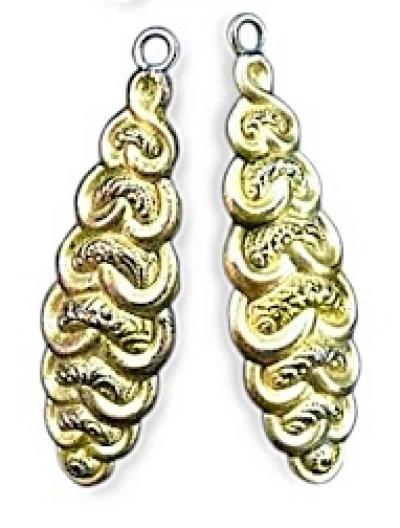
ear pendants from
Boulogne sur Mer
|
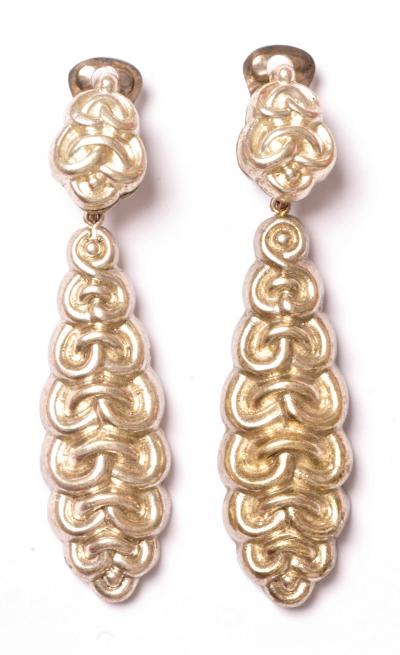
Milanos ear pendants in silver plate, modern copies
Bijoux boulonnais re
|
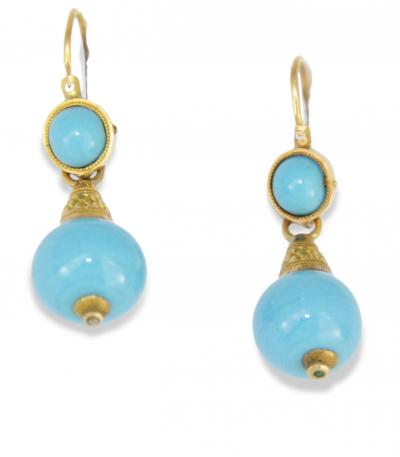
small gold and glass ear pendants from
Le Courgain (the fishing port of Calais)
|
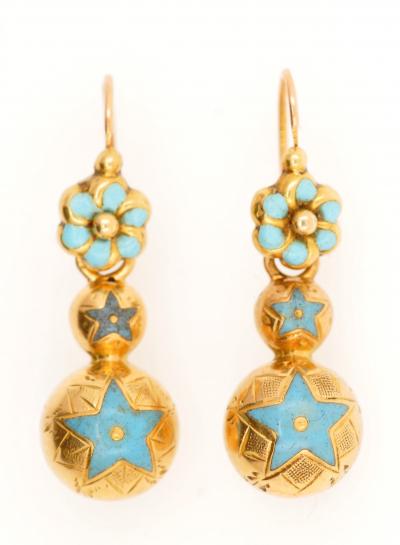
small gold and enamel ear pendants from
Le Courgain (the fishing port of Calais)
|
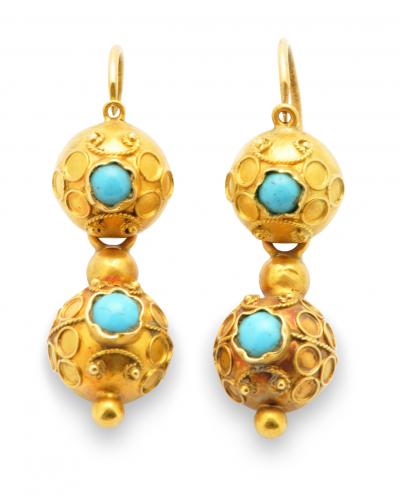
small gold and turquoise ear pendants from
Le Courgain (the fishing port of Calais)
|
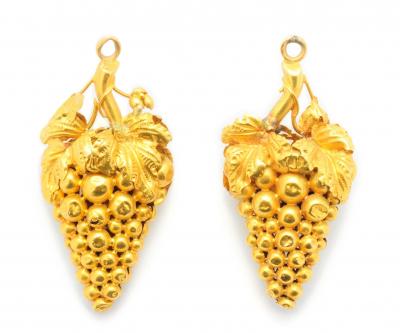
a very rare pair of "bunch of grapes" ear pendants from Courgain in gold
(the small sleeper earrings from which they would have been suspended are missing. Most women had only one pair or sleepers which were worn permanently and several pair of larger pendants to suspend from the sleepers as the occasion demanded)
Bijoux boulonnais re
|
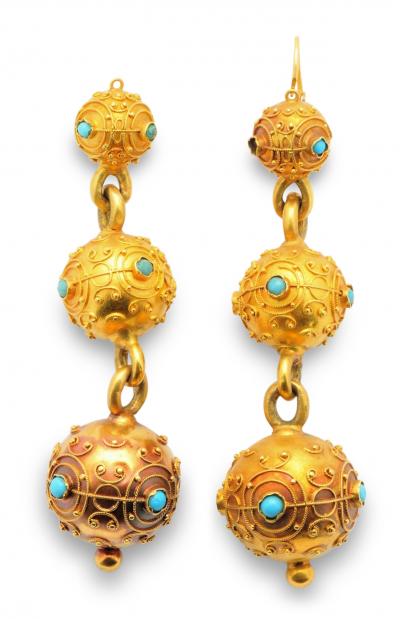
gold and turquoise ear pendants from
Le Courgain (the fishing port of Calais)
|
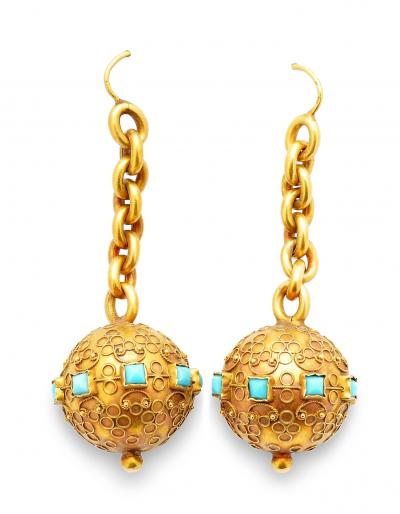
gold and turquoise ear pendants from
Le Courgain (the fishing port of Calais)
|
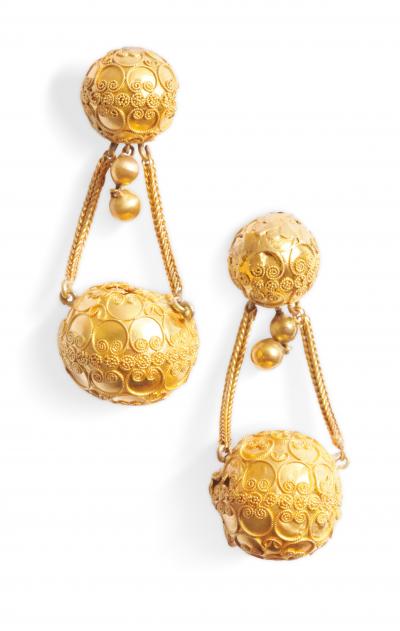
rare pair of ear pendants from
Le Courgain in gold and filigree
|
Don't forget to click on the photos to see them in higher resolution!
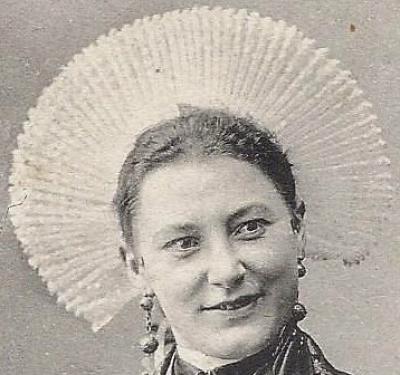
long ear pendants like those shown above
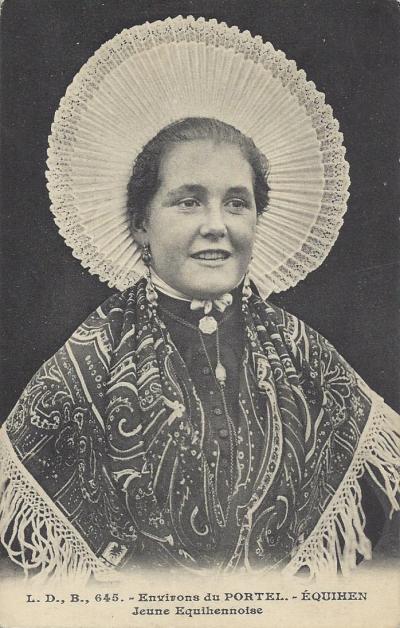
large ear pendants d'oreille known as "Cloches d'or " or "Monstreuses"
with the long neckchain called "sorcière" and the sun coiffe. Equihen, post card
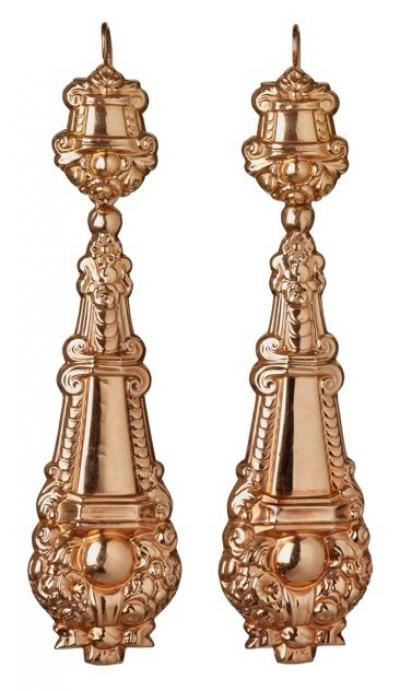
large ear pendants called "Les cloches d'or" or "Les Monstreuses"
|

Carole Bouquet, a French actress wearing Milanos ear pendants
|
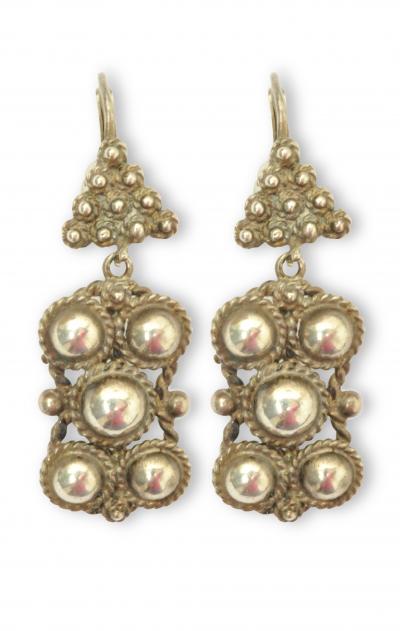
silver ear pendants from the Boulogne region
Sorcière chain
An integral part of the regional costume of the women of the Northern coast was the "sorcière" chain. Very long and made in different links and weights according to the means of the buyer, it was closed with a barrel-shaped catch.
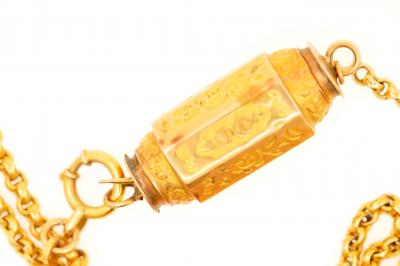
Catch of a sorcière chain in gold
Rings
The traditional wedding ring in the North of France was the "Turquoise" ring, set with one or more lines of small round or oval turquoises or blue glass imitating turquoise. The traditional love-knot and Lisbonne rings are still very popular in the region today, many women wear them and they sell well in the local shops. The nine hemispheres on the love knot rings are said to represent the nine months of pregnancy and these rings are often passed from mother to daughter. Unfortunately most of the love-knot and Lisbonne rings sold today are copies of copies of copies, made by casting rather than assembly and the fine workmanship is no longer there.
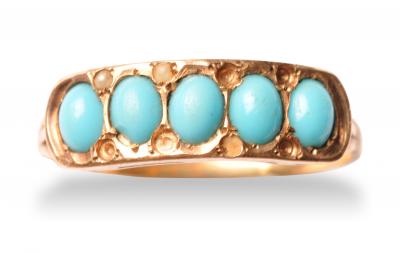
"Turquoise" ring in gold set with blue glass imitating turquoises and seed pearls (some missing)
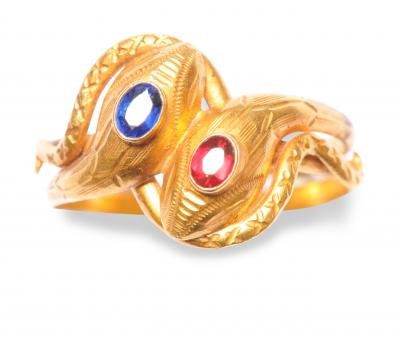
Snake ring set with sapphire and ruby, populair in the North Pas de Calais region and Normandy(150%) |
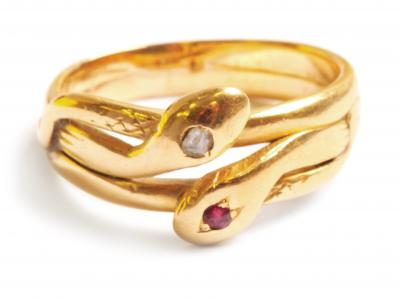
snake ring in gold, diamonds & rubies,
particularly popular in the north of France and Normandy
|
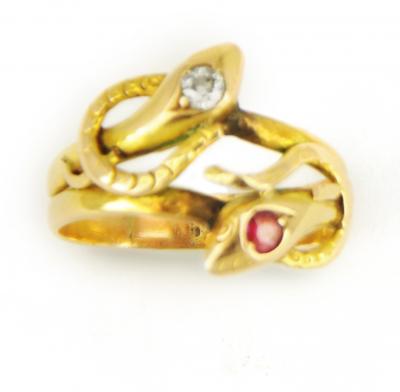
snake ring in gold,
diamonds & rubies |
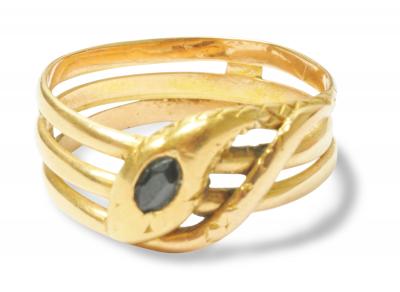
snake ring in gold and sapphire,
particularly popular in the north of France and Normandy |
|
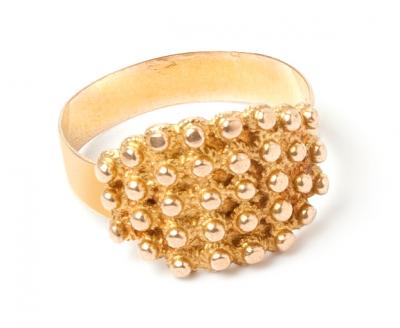
Lisbonne ring in gold,
regional jewellery from northern France |
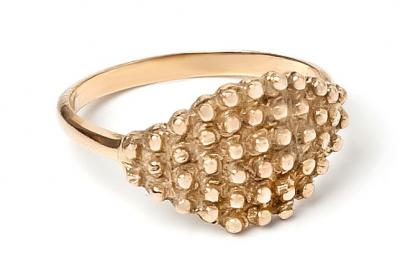
Lisbonne ring in gold,
regional jewellery from northern France |
The capelet rings, with their motifs of faith, hope and charity (the cross, anchor and heart respectively), were worn by the fishermen as well as by their wives. The oldest ones are found with ten small spheres soldered onto the shank, which served to count the prayers said at night. The name capelet comes from the fact that these rings were in effect used as truncated rosary beads, "chapelets" in French. In silver or brass they were often given to the children who accompanied their parents to the jewellers, an expedition called "aller aux dorlots", whilst the jeweller himself was known as the "dorlotier". According to Lionel Bonnemère (1), these Capelet rings were offered to girls for their first holy communion throughout France; however one tends to come across them more often in the north of France.
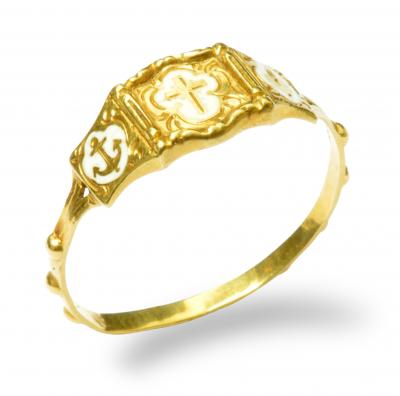
capelet ring in gold and enamel |
|
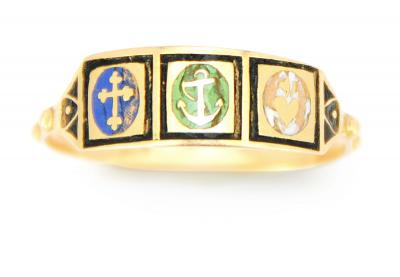
capelet ring in gold and enamel |
|
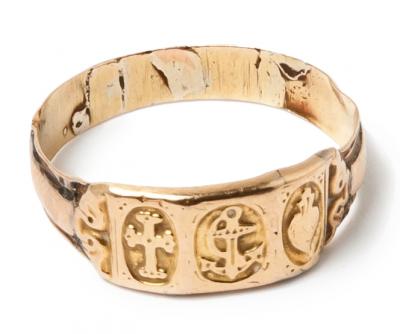
gold capelet ring
(note the numerous repairs) |
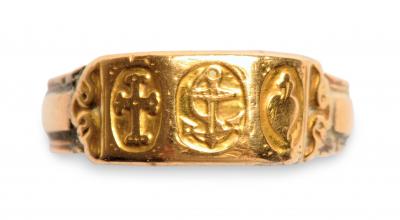
capelet ring in gold
The three pansy brooch
The three pansy brooch consists of three oval medallions, each decorated with a pansy, generally enameled. Traditionaly worn in the north of France as either a brooch or a necklace, the three pansys represent a thought for the past, a thought for the present and a thought for the future. (Pansy in French is pensée, which is a synonyme for "thought" or "think". )
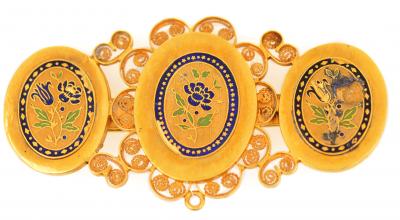
Three pansy brooch from the north of France, gold and enamel
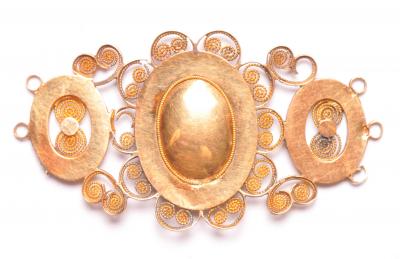
Stylised three pansy necklace from the north of France, gold
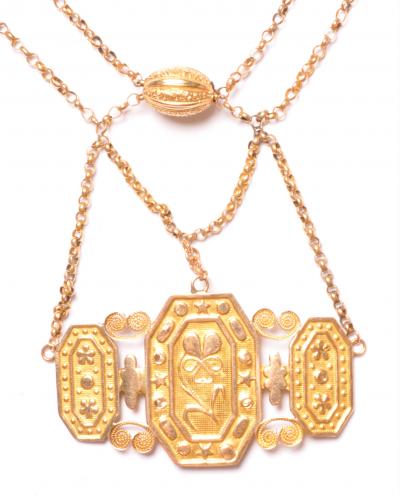
Three pansy necklace from the north of France, gold
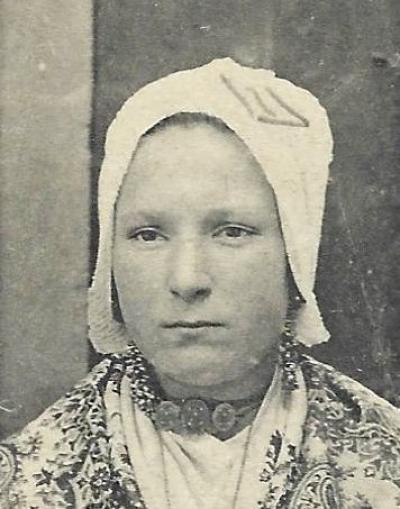
Three pansy necklace worn with regional costume from Le Portel
The Boulogne or pardon cross
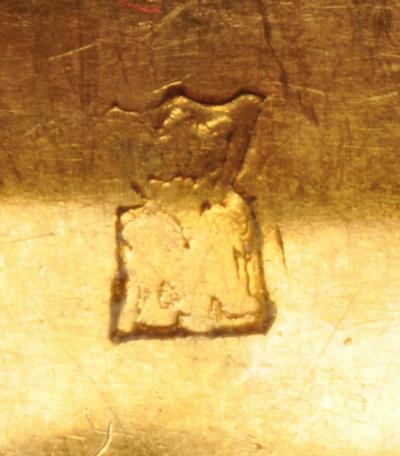
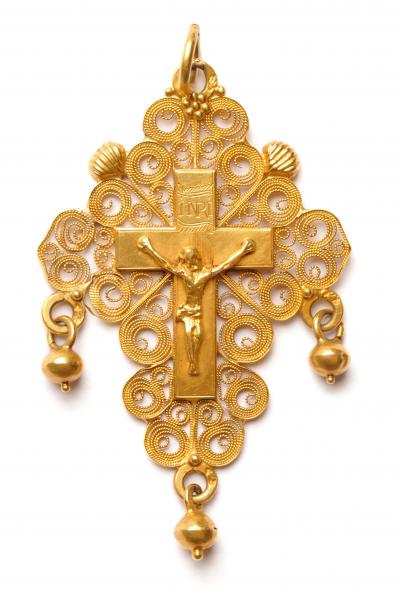
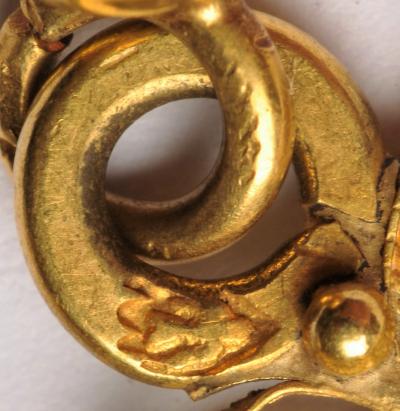
18th century Portel or pardon cross, gold
Note the three pendants, representing the tears of Christ
The Boulogne cross or pardon cross has spirale filigree decorations around the crucifix which suggests the ropes of the fishing boats. These crosses were mainly worn around the Portel region, a fishing area of Boulogne-su-Mer, where they are distinguished by the scallop shells designs at the extremities of the cross. The crosses from the Calais region are similar, the only difference being that they have little flat gold pearls at the extremities called grelots.
It is often said that that the fashion for filigree jewellery was imported from Spain which occupied the region in the 17th century, however jewellery was very rare at that time and one finds no French regional jewellery with filigree from the 17th century. It is more likely that the techniques of filigree were adopted by the local jewellers after seeing or being asked to copy jewels brought back by sailors or fishermen after stopovers in the gulf of Gascony. The technique of filigree work is not difficult in fact, one only needs to twist two gold wires together, pass them through a roller to flatten them a bit, wind them into a design and then fix the design with a few spots of solder. The older pardon crosses have three pendants, by about 1820 the crosses evolved into having only one pendant. An example in the collection of the MuCEM at Marseille, inventory number 1991.24.1 which is dated to between 1809 and 1819 still has three pendants. Crosses with three pendants are very hard to find today.
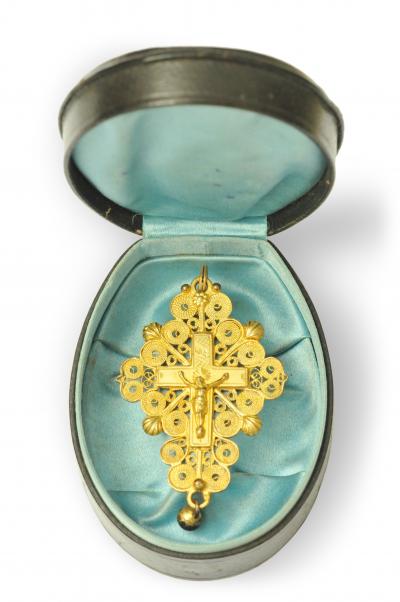
cross from Le Portel or pardon cross, gold-plated brass in its original box
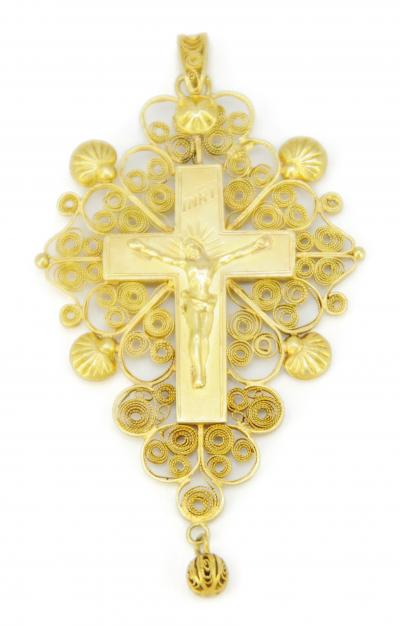
cross from Le Portel
or pardon cross, gold |
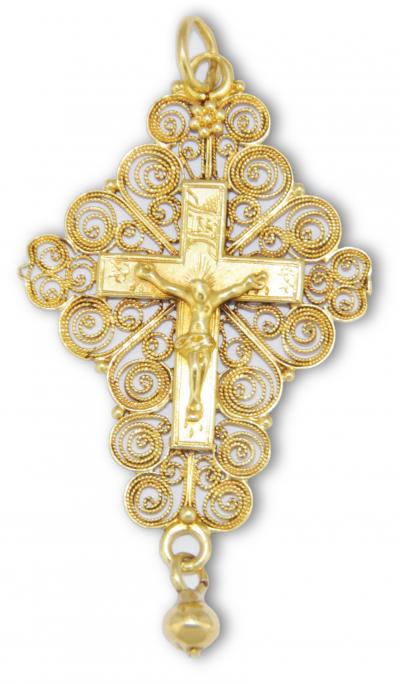
cross from Calais
or pardon cross, gold |
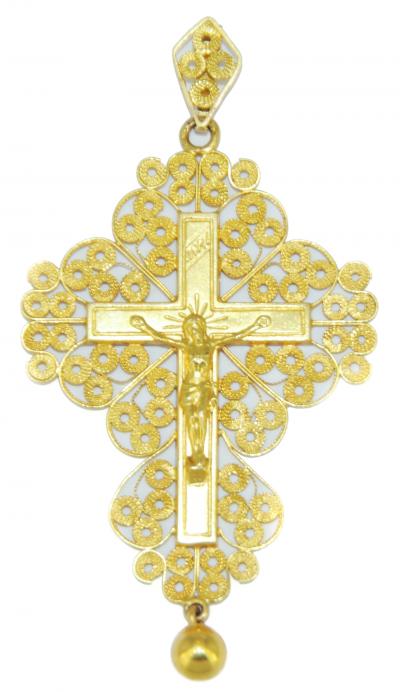
cross from Calais
or pardon cross, gold |
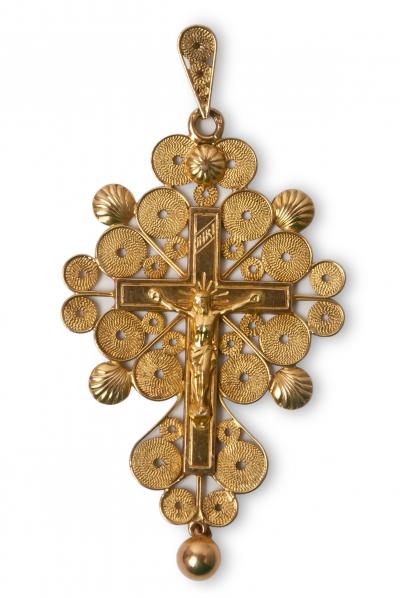
cross from Le Portel
or pardon cross, gold |
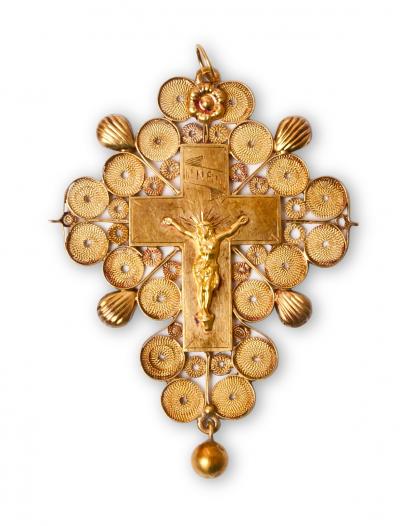
cross from Le Portel
or pardon cross, gold |
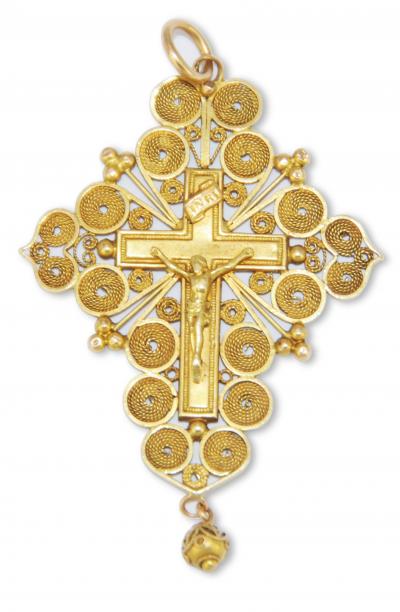
cross from Calais
or pardon cross, gold |
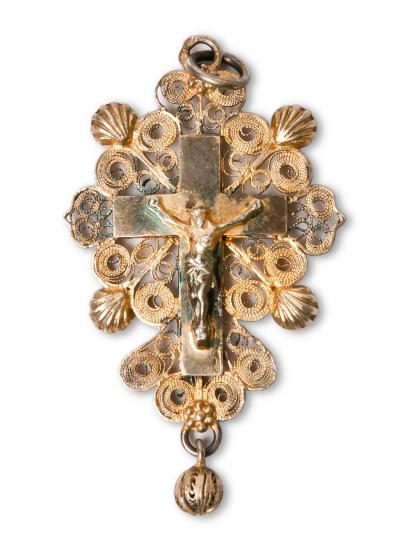
cross from Le Portel
or pardon cross, silver gilt |
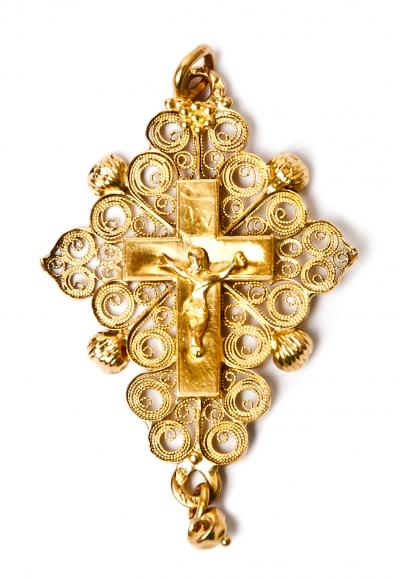
cross from Le Portel
or pardon cross, gold |
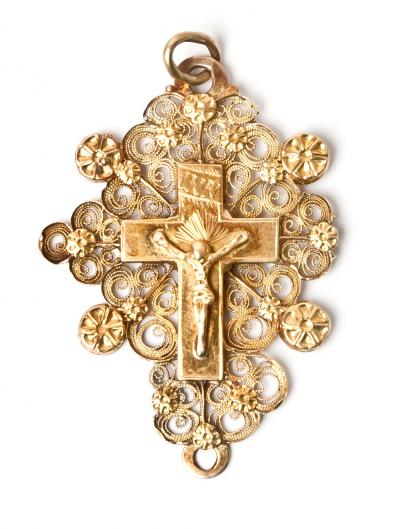
cross from Calais
or pardon cross, gold |
|
|
|

pardon cross in plated gold
|
|
|
There is an interesting early variety of the pardon cross, examples of which were made exclusively in Belgium, though they are sometimes marked with French hallmarks. The reason is that some of them were made in Belgium during the time it was occupied by France between 1793 and 1815.
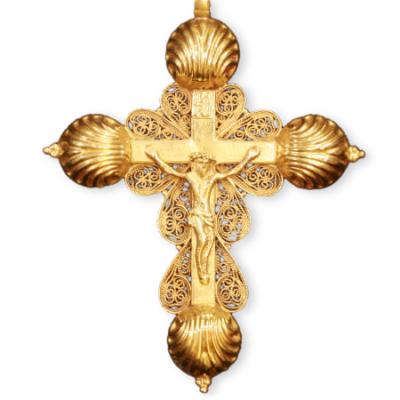
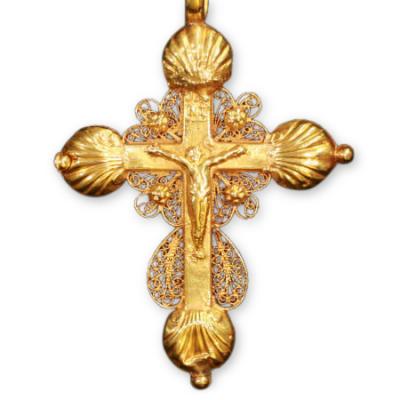
Two Belgian pardon crosses in gold with French rooster's head hallmarks on one, Belgian hallmark from 1770 on the other
Bijoux boulonnais regional
Flemish papillon (butterfly) cross
These papillon (butterfly) crosses, though made in Belgium, were also worn in the north of France and even in Normandy. (It's worth bearing in mind that Belgium was a province of France between 1793 and 1815) In Belgium they are known as "croix à la Jeannette".
The cross is composed of two articulated elements and the slide, if present, is fixed directly to the cross and provided with two bands at the rear to hold the ribbon. The cross is formed of thin curled silver bands and set with diamonds mounted in silver cones and is backed with a thin coating of gold to prevent the silver from blackening one's clothes. The design of the Flemish papillon cross is in fact quite different from that of the provençale papillon crosses, though they are often confused with the latter.
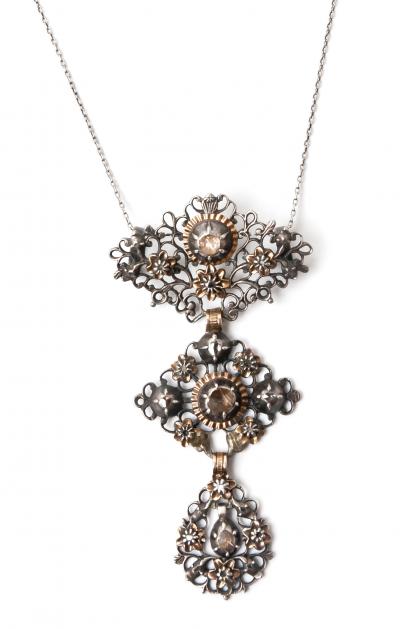
papillon cross, c1800-1840
in gold, silver & diamonds |
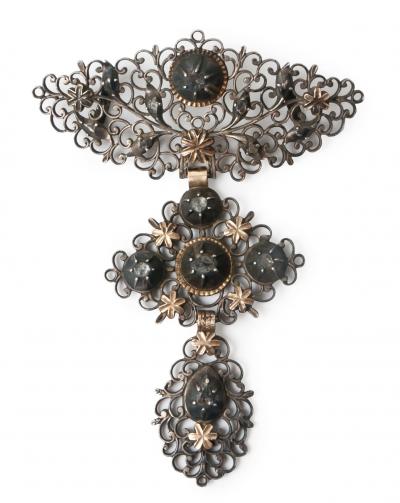
papillon cross, c1800-1840
in gold, silver & diamonds |
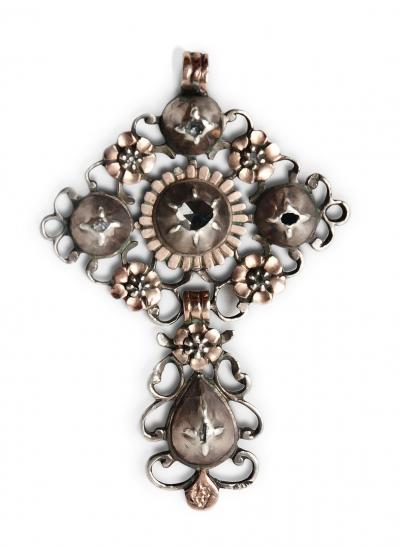
papillon cross
in gold, silver & diamonds |
Vlaamse Hart pendant
Vlaamse Hart pendants originated in Antwerp at the end of the eighteenth century and are made in gold-backed silver set with rose-cut diamonds. The majority were produced between 1780 and 1850. Examination of the 38 examples in the treasury of the Antwerp churches reveals that 10 have no hallmarks, 6 were made in southern Belgium during the Dutch rule, 14 in Mechelen, 7 in Antwerp and one in Ghent. The name Vlaamse hart translates to “Flemish heart” and they represent the heart of Mary. There are two types of Vlaamse hart pendants; one has a simple wreath of flowers set above the lower half, see left-hand photo, while the other, which was offered as a love token, is crowned with a bow and a quiver, a flaming torch and some foliage. They were worn sometimes in the north of France and I have come across several in Normandy as well. (It’s worth remembering that Belgium was a French province between 1793 and 1815) (2)
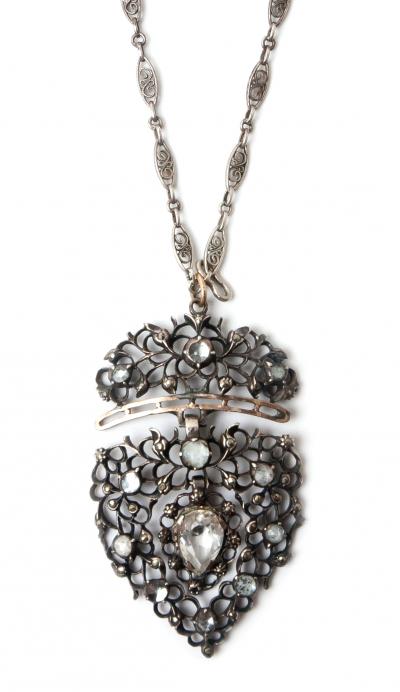
"Vlaamse hart" pendant in gold-backed silver and diamonds |
|
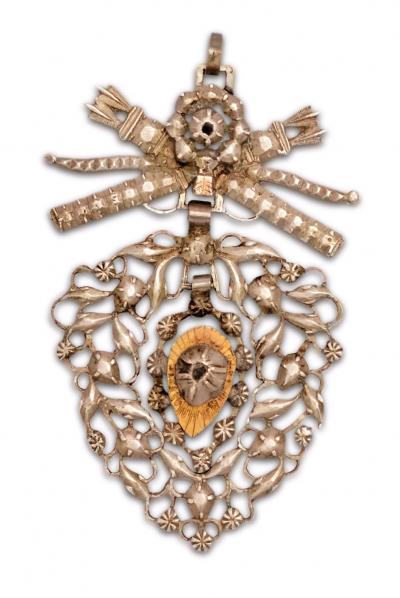
"Vlaamse hart" pendant in gold-backed silver and diamonds
|
|
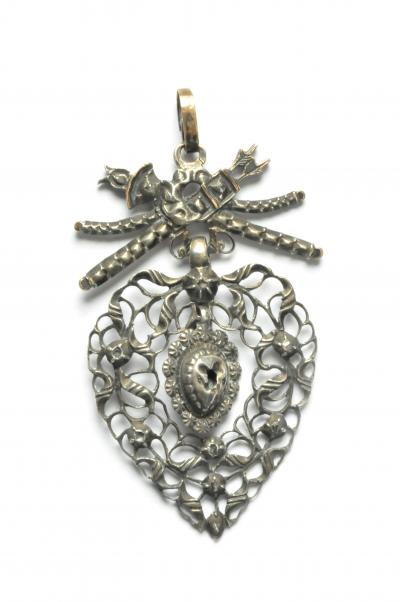
"Vlaamse hart" pendant in gold-backed silver and diamonds
(central diamond missing) |
Belt clip for scissors
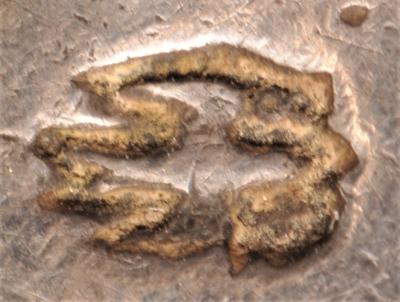
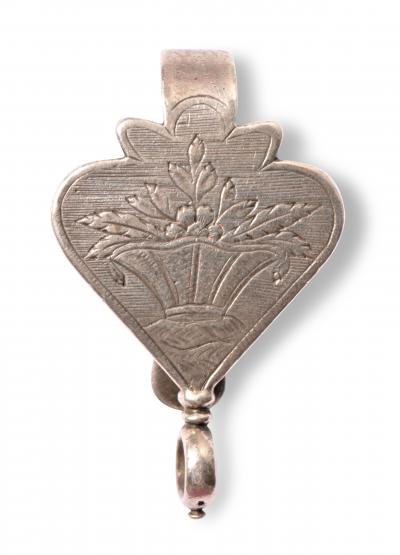
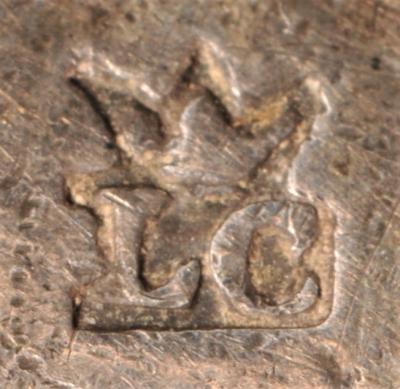
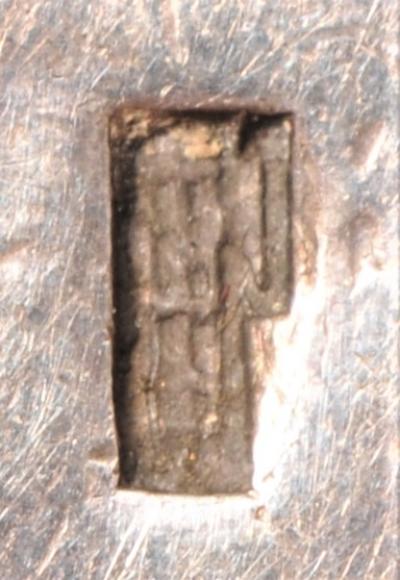
Silver belt clip for hanging scissors, 18th century with Lille hallmark
The pocket watch case
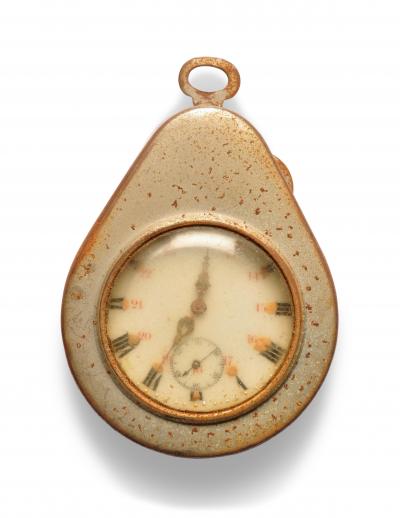
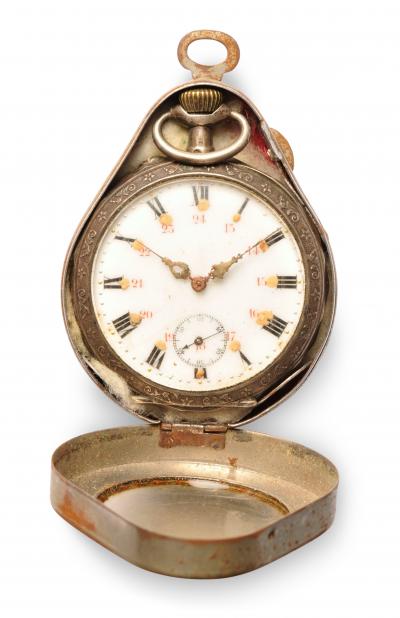
The coal miners in the north of France were particularly fond of these steel cases which they used to protect their silver pocket watches
from damage while working. While not strictly speaking regional jewellery, 95% of these cases that I've seen were offered to me in the north of France.
This particular watch has been painted with phosphorescent paint so that the time can be determined in the dark.
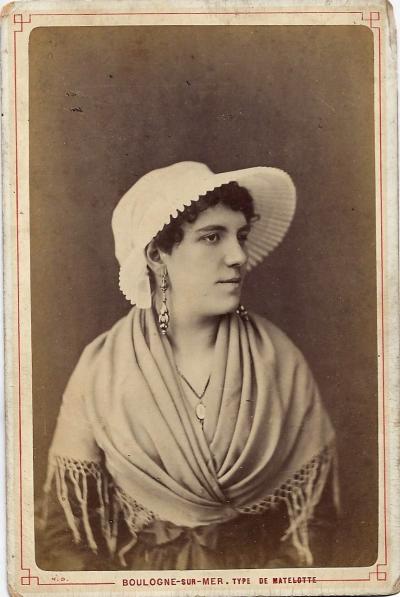
French folk costume with very long
ear pendants and soleil coiffe - Boulogne-sur-Mer - antique photo
|

French folk costume with very long
ear pendants and soleil coiffe - Pas de Calais region - antique photo
|
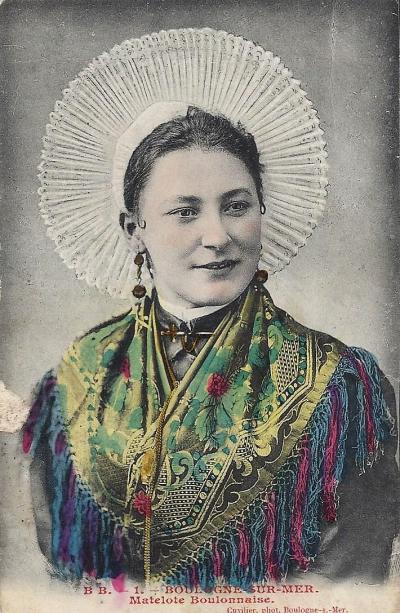
French folk costume with very long ear pendants
and soleil coiffe - Pas de Calais region - antique postcard
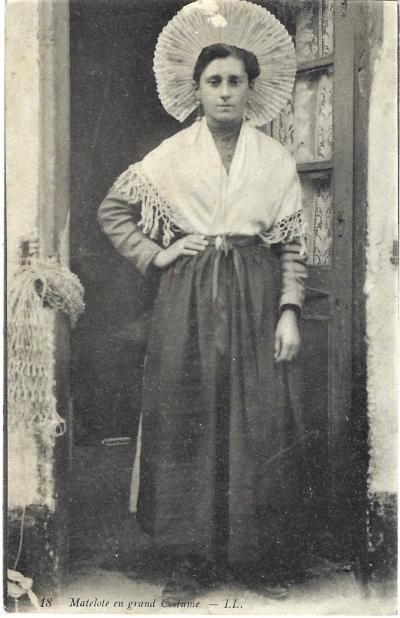
French folk costume with very long ear pendants
and soleil coiffe - Pas de Calais region - antique postcard
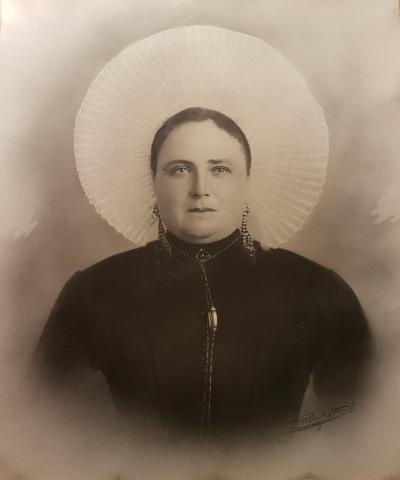
French folk costume with very long Milanos
ear pendants and soleil coiffe - Pas de Calais region - antique photo
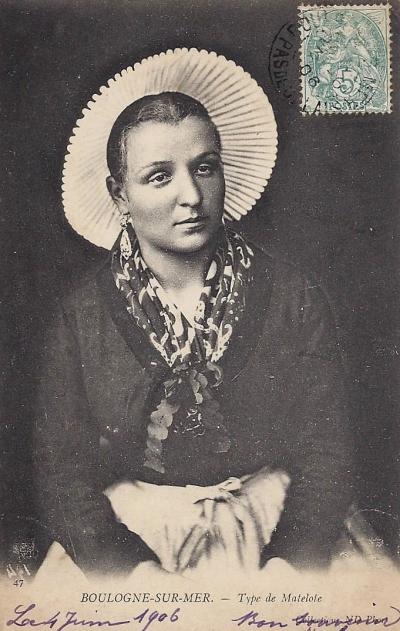
French folk costume from Boulogne-sur-Mer with very long
ear pendants and soleil coiffe - Pas de Calais region - antique postcard
|
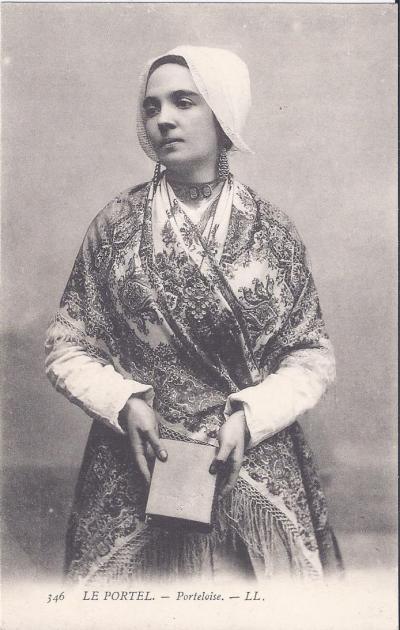
French folk-costume from Le Portel, Pas de Calais region
showing "le Toquet" coiffe, sorcière chain and Milanos ear-pendants.
One can see at her throat the traditionel three pansy necklace. The word for pansy in French, "pensée", is synonyme with "think"
and the necklace represents "a thought for the past, a thought for the present and a thought for the future".
|
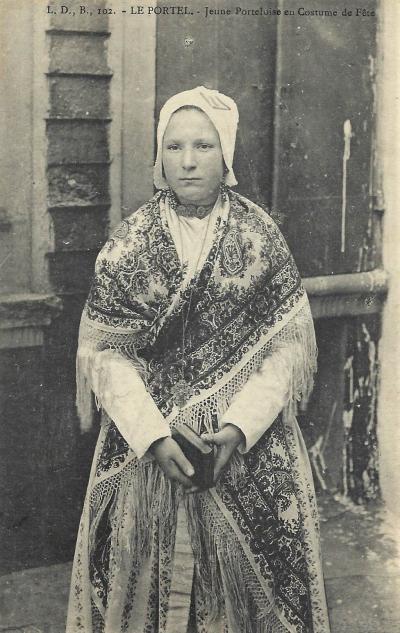
Three pansy necklace and cross worn with regional costume from Le Portel
|

French folk-costume from Equihen, Pas de Calais region
showing sun coiffe, sorcière chain and "Monstreuses" ear-pendants
|
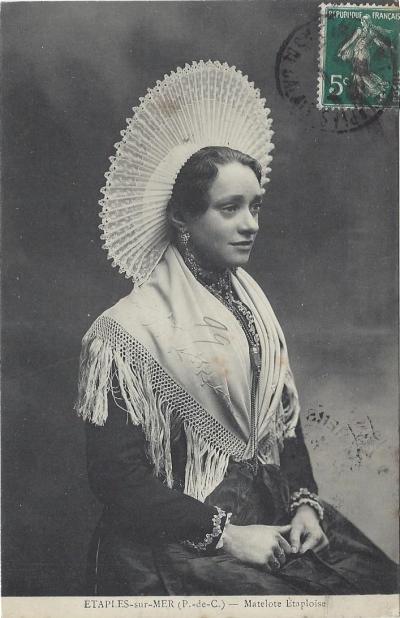
French folk-costume from Etaples, Pas de Calais region
showing sun coiffe, sorcière chain and "grape" ear-pendants
|
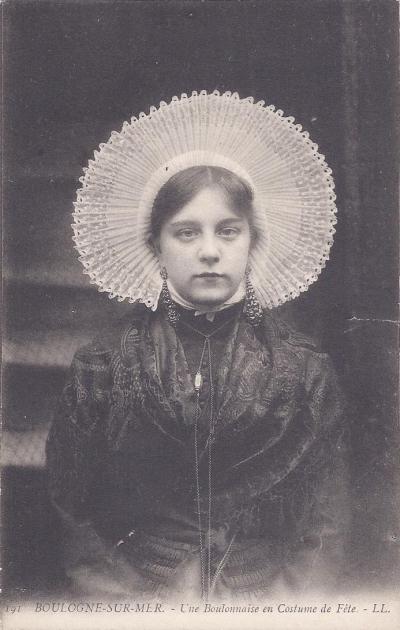
French regional jewellery, 'Milanos' ear pendants
and 'sorcière' chain, Pas de Calais region
|
|
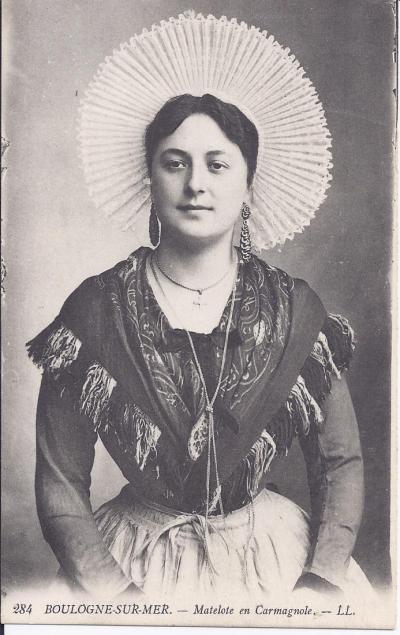
French regional jewellery, 'Milanos' ear pendants
and 'sorcière' chain, Pas de Calais region
|
|
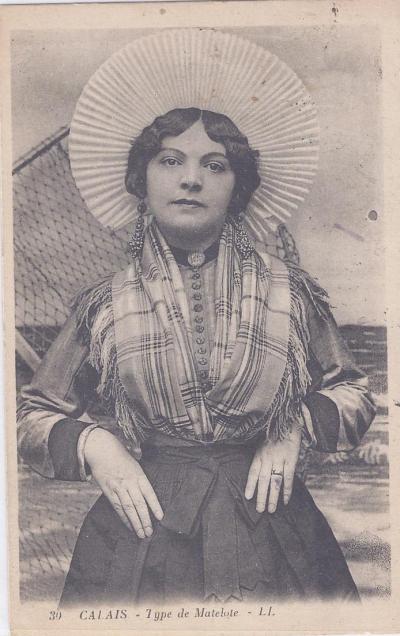
French regional jewelry, 'Milanos' ear pendants
and 'sorcière' chain, Pas de Calais region
|
|
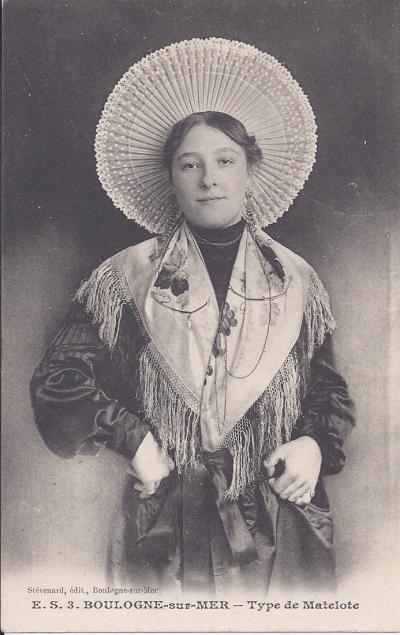
French regional jewelry, 'Milanos' ear pendants
and 'sorcière' chain, Pas de Calais region
|
|
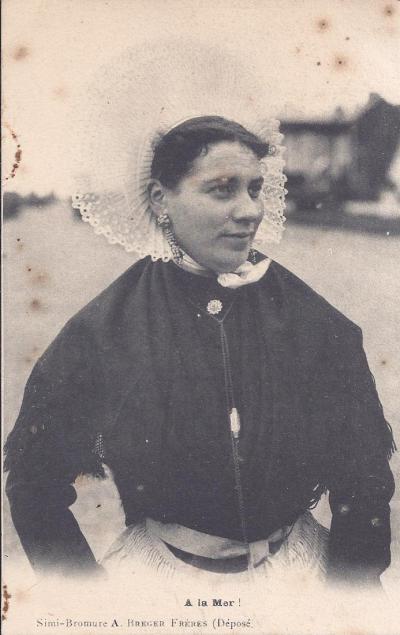
French regional jewellery, 'Milanos' ear pendants
and 'sorcière' chain, Pas de Calais region
|
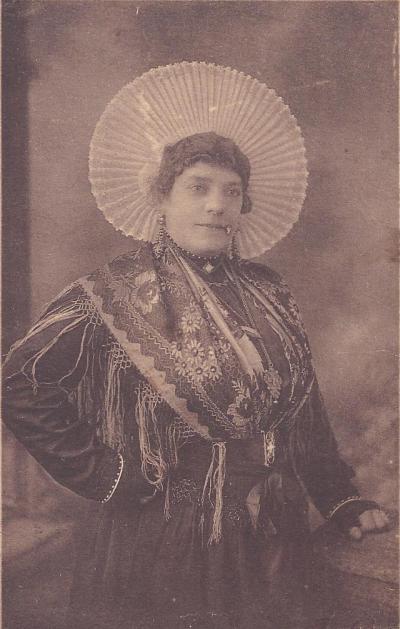
French folk dress with Milanos ear pendants,
long neck chain with pardon cross, Pas de Calais region
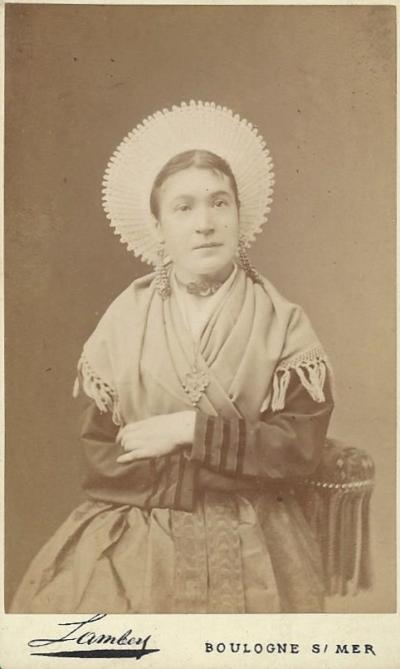
Antique photo of woman in Boulogne-sur-Mer wearing the traditional pansy brooch,
Milanos ear pendants, sorcière chain with pardon cross and three pansys necklace and the sun coiffe.
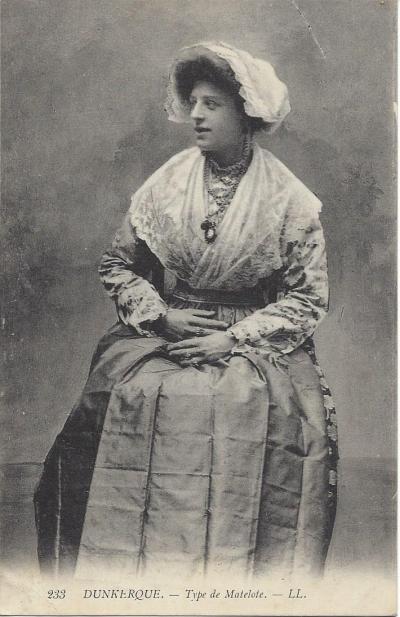
French folk dress with Milanos ear pendants,
long neck chain with pardon cross, Pas de Calais region
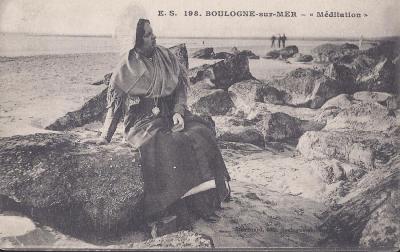
fisherman's wife with sorcière chain, pardon cross and Milanos ear pendants
Contact me with your suggestions, corrections, questions and comments!
1. Lionel Bonnemere, 1843-1905, Playwright, lawyer, collector of folklore and traditional jewellery, the donation of his extensive collection formed the basis of the fledgling Musée des Arts et Traditions Populaires in Paris
2: Uit de sacristie - Textiel en juwelen in kerkelijk bezit in de provincie Antwerpen, Provincial Museum voor Kunstambachten Sterkshof, 1985
contentrs:
croix de Boulogne - boucles d'oreilles Milanos - pendants d'oreilles Milanos - bague Lisbonne - bague noeud d'amour - chaine sorcière - croix de pardon - bijoux boulonnais - coiffe soleil - costume de matelotte - bague capelet - croix de Champagne - croix d'Alsace - broche alsacienne - croix de Lorraine - bijoux des régions de France - les bijoux des Français - les bijoux de France - bijoux régionaux - bijou régional - croix écotée - pendentif Saint Esprit - Saint Esprit d'Aurillac - rose de Velay - collier d'esclavage - croix de Puy en Velay - croix d'Auvergne - bijoux d'Auvergne - bijoux auvergnat - collier Saint Esprit de Puy en Velay - croix de Velay - bijoux d'Auvergne et du Velay - costume regional - bijoux régionaux - coiffe - coiffe auvergnat - bijoux des régions de France - bijoux régionaux - les bijoux traditionnels Français - croix régionales - Léon Giron - Antoine Raspal - Thomas Desgeorge - Estella Canziani - esclavage auvergnat - French regional jewellery – jewelry - French traditional jewellery – jewelry - French folk-dress - French folk costumes - antique French jewellery - les bijoux de France - les bijoux des Français - Vlaamse hart- antieke zeeuwse streeksieraden in Friesland - Streeksieraden en Zeeland - Vlaamse Hart - Brabantse klederdrachten en streeksieraden
BIJOUX REGIONAUX ANCIENS - BIJOU REGIONAL
French regional jewellery
North - Artois - Flanders region
New book - Traditional French Jewellery
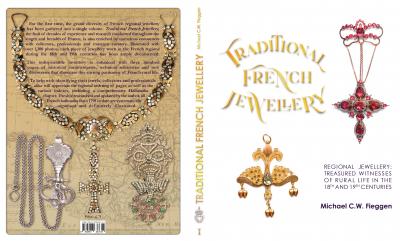
Book - Traditional French Jewellery - order here direct from the author
Dear collectors, auctioneers, dealers and jewellery lovers,
You have visited the site www.bijouxregionaux.com which for twelve years now has listed all regional and traditional French jewellery, without advertising and without sales. By popular demand, this website is now finally available as a book, much more complete and with many new photos and texts that are not on the site. I traveled more than 4,500 km in 2020 to visit the various collectors and museums of France and to photograph, weigh, measure and examine their jewellery.
Large format of 23.5 x 30 cm, 304 pages, hardcover and fully illustrated with over 1300 jewels in color, this book is the first complete book on French regional jewellery and corrects the many errors and gaps observed in the other references and presents other regional jewels hitherto unknown to the public. You will find eight full pages on Breton pins and fibulae and many other jewels in museums and private collections that are not on this website. Over four months of research has gone into making the chapter on hallmarks the most reliable ever seen - clear illustrations of hallmarks have been made especially for this volume. And for the first time, collectors will have access to a complete list of all the assay office symbols, small signs withn the hallmarks that identify in which city the jewellery was hallmarked. The opening and closing dates since 1798 of the hallmark offices are also listed for the first time, allowing, with the office symbol, to better date your jewellery.
The print run of this book is very limited, which is why I recommend you order early. You will love this book I have had nothing but compliments and many clients have ordered more to offer as gifts.
To order, you can send a wire transfer or WISE transfer to Michael Fieggen - FR76 4061 8803 9700 0403 3233 171 – BIC – BOUSFRPPXXX - address Mike Fieggen, 280 rue Saint Honoré, Paris, 75001 France
Bank or wire transfer by www.wise.com in Sterling – Account holder - Michael Fieggen
IBAN - GB68TSBS30916200184462 BIC / SWIFT - TSBSGB2AXXX
Sterling cheques and PayPal welcome to address demosthenesparis@gmail.com.
Any questions ? Contact me at bijouregional@gmail.com or by telephone at + 33 1 4015 9000
One copy in French €75 Postage and packing €9 for France, €8 for Europe and overseas
Two or more copies in French €75 each Postage and packing €9 for the lot in France, overseas postage €8 each
One or more copies in English £75 sterling each Postage and packing £8 sterling each
